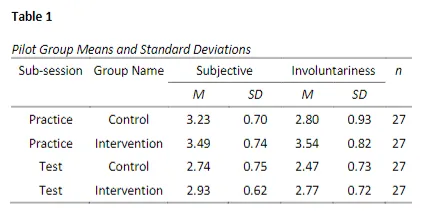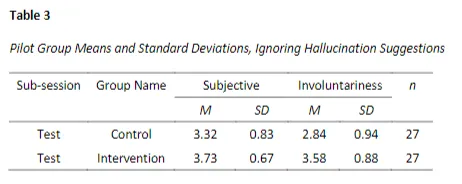503 - Direct Volitional Modification
An easier-to-read overview of Kevin Sheldrake and Zoltan Dienes’s paper Can Imagining Actions as Occurring Involuntarily Cause Intentional Behaviour to Feel Involuntary?. Geared towards the recreational dealer in hypnosis. The spoiler here is - you may have easy, low hanging fruit to grab with motor suggestions by giving these suggestions:
- Engage your imagination
- Do your best to succeed with the exercises
- Try not to worry about how good their imagination is.
- Intentionally produce the behavior and imagine it as involuntary
- If some thought or cue reminded them that it’s voluntary - try to imagine that away as well
Read on for more!
Abstract
Section titled “Abstract”This paper aims to find if we can use imagination to directly modify how voluntary a suggestion feels. It highlights that imagination itself does not generate a feeling of a response being involuntary. For instance - if you imagine chilling out a beach, you wouldn’t be surprised if this relaxed you. This paper views volition as an affective (emotional) component, rather than a cognitive component.
Can Imagining Actions as Occurring Involuntarily Cause Intentional Behaviour to Feel Involuntary?
Section titled “Can Imagining Actions as Occurring Involuntarily Cause Intentional Behaviour to Feel Involuntary?”This exploration will not use trance / an induction for hypnosis, as the inductions are largely irrelevant for the purposes of this examination. They’re also not going to use the word “hypnosis” in this study. Or - put more recreationally - we’re going to be looking at ‘hypnosis without trance,’ dropping the hypnotic context.
Theories of Phenomenological Control
Section titled “Theories of Phenomenological Control”I’ve written about this in depth elsewhere, so here’s a quick rundown:
- Socio-cognitive theories explained hypnotic response as being built on self-deception (reframing) and role enactment (being hypnotized)- which can be coached and trained. In short, these theories did not explain how the changes in attitudes, motivations, and expectancies led to increased feelings of automaticity. (Pulling in some personal reading - expectancy itself is correlated with, but does not always predict the degree of hypnotic response… therefore, it’s a component, not the deterministic factor.)
- Wagstaff said we could just be distracted from the fact that we’re making something happen. Kev suggests that inherently - distracting yourself from something feels like you’re distracting yourself - not some crazy automatic hypnosis vibe.
- DCT (dissociative control theory) suggests our (motor control) intentions are separate from our executive monitoring abilities, so these could be dissociated. This theory suggests that the responses are intentional, we’re just not aware of them.
- I wrote a quickie about cold control here.
Enhancing Phenomenological Control
Section titled “Enhancing Phenomenological Control”I wrote all about the CSTP here. The CSTP had replication issues…
- People reminded to “be honest” in their responses scored lower. This doesn’t mean the subjects were necessarily dishonest - they were just asked to reframe their responses in a more realistic (less hypnotic) manner.
- Simulators don’t respond when they don’t think they’re being observed, but both natural highs and CSTP trained highs respond well. This rules out the social demand characteristics.
- Wickless and Kirsch experimented with just creating conditions that’d make it look like hypnosis was working. 😅 The had set up a room, suggested the colors of the light would change, and found a crafty way to change the room lighting that was subtle but noticeable. People responded a lot better to subsequent suggestions in the deceptive conditions. Knowledge of the deception unsurprisingly greatly lowered response.
Here’s a handy nugget. Making the following modifications to an arm immobilization suggestion improved effectiveness… - Imagine their arm was immobile - And imagine that there was nothing they could do about it This greatly improved response.
Back to our original question - what makes response feel automatic? They highlight imagination itself does not make something feel unintentional. (EG: Just telling someone to imagine a balloon to their wrist filled with helium without a hypnotic context probably won’t do much.) So something happens in the hypnotic context. Perhaps there’s a direct way to practice or train not having higher order thoughts of intention.
In their own study - their motivational suggestions were wholesome. 🧡
- Engage your imagination
- Do your best to succeed with the exercises
- Try not to worry about how good their imagination is.
The intervention group was asked to:
- Intentionally produce the behavior and imagine it as involuntary
- If some thought or cue reminded them that it’s voluntary - try to imagine that away as well
According to cold control - this should increase both the subjective experience (how strong did that feel) and feelings of how involuntary it feels, given compliance.
Pilot Experiment (and promising results!)
Section titled “Pilot Experiment (and promising results!)”I’m glossing over quite a bit - but here’s some important bits I pulled out:
- Sessions were split into practice and test phases.
- In the practice phase…
- The “intervention” group was given the 3 motivational suggestions mentioned earlier.
- The “control” group was not given these suggestions.
- Both groups got some of the usual suggestions - hand lowering, hands moving together, hands stuck together.
- The intervention group got some coaching - they were given up to 5 attempts to improve their response, as well as some conversational assistance in trying to find something to help their imagination along. The experimenter encouraged the group to imagine not being aware of thoughts and feelings that would remind them of their volition.
- In the test phase…
- You guessed it. They were tested on… “mosquito hallucination, arm immobilisation, taste hallucination, arm rigidity, music hallucination, and hand rising.”
Yoink! (from page 15)
(I’m a dumbass, and had to remember that M stood for Mean and SD stood for Standard Deviation.) Take a look at those differences between the control and intervention responses.

The results looked more prominent when the hallucination suggestion responses were ignored..

The TLDR takeaway is that because there was no training on how to execute hallucination suggestions, there was little improvement there. (In this study - they didn’t train or coach people on them, just the motor suggestions.) You can find some inspiration on how you might train these with the CSTP.
(Shout out to a friendly reader that pointed out details I missed.)
Pre-registered Experiments
Section titled “Pre-registered Experiments”The rest of this is mostly a talk on how to not shoot yourself in the foot in an academic setting doing a study. In their discussion on their next study - they plan on training for hallucination suggestions, and seeing if they generalize.
You may want to consider recreationally suggesting or working with…
- Feelings of realness and involuntary response in motor suggestions
- Feelings of realness and involuntariness in hallucinations
- Personal thought - Feelings of realness and involuntariness in amnesia/memory suggestions. (You know the drill. Safety third, go slow!)
- Re-trying old suggestions after some training. Like that trigger you couldn’t get to stick.
Also some personal thoughts (or things I forgot I heard from book club - apologies if I’m missing attribution!):
- Suggesting that you need to practice a hypnotic response could backfire. Kirsch (and others) wrote about how in some studies, there was a “holdback effect.” A subject may know that later they’ll be asked to respond hypnotically, therefore, they wouldn’t allow themselves to fully immerse themselves in an experience until later.
- It’s exciting to see some of this work as a promising panacea, but we’re working with people, not statistics. Even if we do find we can directly modify the affective component of how automatic a response is, it doesn’t mean the same suggestions are appropriate for every individual. (EG - if you’re primarily a clinical hypnotist and you present the same suggestions in the same manner as a street hypnotist, you’ll likely get very different (poor) results just from changing social context.)